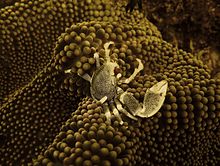Porcelain crab
| Porcelain crabs Temporal range: Tithonian–Recent |
|
|---|---|
 |
|
| A Porcelain crab in Mauritius | |
| Scientific classification | |
| Kingdom: | Animalia |
| Phylum: | Arthropoda |
| Subphylum: | Crustacea |
| Class: | Malacostraca |
| Order: | Decapoda |
| Infraorder: | Anomura |
| Superfamily: | Galatheoidea |
| Family: |
Porcellanidae Haworth, 1825 |
| Genera | |
|
See text |
|
See text
Porcelain crabs are decapod crustaceans in the widespread family Porcellanidae, which superficially resemble true crabs. They have flattened bodies as an adaptation for living in rock crevices. They are delicate, readily losing limbs when attacked, and use their large claws for maintaining territories.
Porcelain crabs are small, usually with body widths of less than 15 mm (0.59 in). They share the general body plan of a squat lobster, but their bodies are more compact and flattened, an adaptation for living and hiding under rocks. Porcelain crabs are quite fragile animals, and will often shed their limbs to escape predators, hence their name. The lost appendage can grow back over several moults. Porcelain crabs have large chelae (claws), which are used for territorial struggles, but not for catching food. The fifth pair of pereiopods is reduced and used for cleaning.
Porcelain crabs are an example of carcinisation, whereby a noncrab-like animal (in this case a relative of a squat lobster) evolves into an animal that resembles a true crab. Porcelain crabs can be distinguished from true crabs by the apparent number of walking legs (three instead of four pairs, the fourth pair is reduced and held against the carapace), and the long antennae originating on the front outside of the eyestalks. The abdomen of the porcelain crab is long and folded underneath it, free to move.
Porcelain crabs live in all the world's oceans, except the Arctic Ocean and the Antarctic. They are common under rocks, and can often be found and observed on rocky beaches and shorelines, startled creatures scurrying away when a stone is lifted. They feed by combing plankton and other organic particles from the water using long setae (feathery hair- or bristle-like structures) on the mouthparts.
...
Wikipedia
